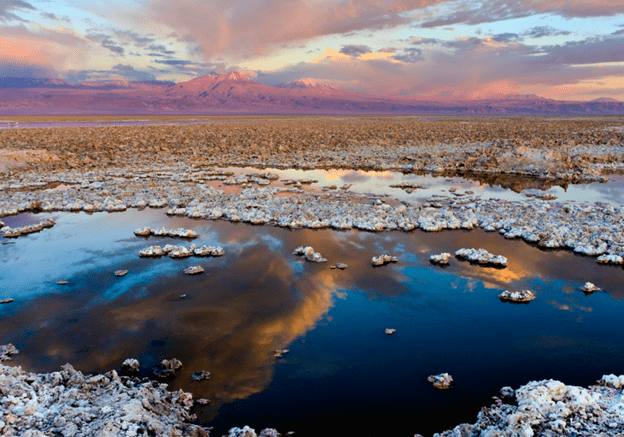by Oscar Neyra
We are entering a momentous time in history, a time only comparable to the moment when the steam engine started the industrial revolution: The Electric Vehicle (EV) revolution. As electricity becomes cheaper and battery storage capabilities increase, electric vehicles are starting to compete against fossil fuel cars due, in part, to the low cost to charge them. This is creating extraordinary opportunities such as the increase in the demand for Electric Vehicles. However, this revolution comes with a trade-off: unsustainable mining.
Manufacturing batteries for Electric Vehicles requires the supply of certain materials such as nickel, cobalt, and lithium. And the extraction of these materials is often done through unsustainable practices such as open-pit mining or brine mining. One of the most devastating examples of the pressure the demand for these materials puts on the environment is the extraction of Lithium from brines. This type of extraction brings major environmental and societal problems, the most relevant of them: water scarcity (Schmidt, et al 2016). But to understand why it is so damaging, we need first to understand how it is extracted.
Lithium exists naturally in underground deposits. It can be found in salt beds or in brine along with other minerals such as sodium and potassium. The majority of the lithium that we use today is extracted through lithium brine recovery. This technique involves pumping water through salt beds and then storing the mineral-rich water in large, shallow ponds. It takes months or even years for the sun to evaporate the water in these ponds. Once most of the water has evaporated and there is a sufficient concentration of lithium, the contents of the pond are moved to a site where the lithium can be processed out of the solution (Flexer, et al. 2018).
The environmental problem relies on the fact that lithium is often found in some of the driest regions of the earth. So, its extraction becomes a paradox, as a lot of water needs to be used in the driest regions of the earth. Water is often taken from aquifers that feed the life of the biomes that exist in those particular regions (Baspineiro, et al. 2020). Water would otherwise be used to nourish the livestock and crops of the communities that live in those areas. So, lithium extraction is perhaps the perfect example of an INFEWS problem, as the energy transition creates the demand for a material that uses water, which would otherwise be used to produce food. This is the environmental challenge of our century.
To address this challenge, I decided to approach such a problem through entrepreneurship and INFEWs-inspired innovation. I created LISUS, a mineral extraction start-up that aims to decrease the environmental impacts of such material. To accomplish this, LISUS incorporates multidisciplinary innovations that decrease water consumption and lower the ecological impact of lithium extraction.
The influence of the INFEWS program in the creation of LISUS is significant, and the concept would not have been possible if I was not introduced to the multidisciplinary research that is being done in our group. The opportunity to be part of the INFEWS program has allowed me to learn from students working on membrane separation, mechanical engineering, and thermodynamic principles. These are areas of expertise that are of critical importance to the EV industry.
Recently, LISUS qualified for the very competitive venture incubation program at Harvard, the Semi-Finals of the MIT Climatech competition, the finals of the Viterbi MEPC challenge, and the Finals of the Easton Technology competition. These would not have been possible if it were not for the advice that we received from the friends of our cohort. I have no doubt that their knowledge and advice will give us a better shot at solving the INFEWs problem of this century.

Photo by Francesco Mocellin. (2009). Source
References
- Flexer, V., Baspineiro, C. F., & Galli, C. I. (2018). Lithium recovery from brines: A vital raw material for green energies with a potential environmental impact in its mining and processing. The Science of the Total Environment, 639, 1188-1204. https://doi.org/10.1016/j.scitotenv.2018.05.223
- Baspineiro, C. F., Franco, J., & Flexer, V. (2020). Potential water recovery during lithium mining from high salinity brines. The Science of the Total Environment, 720, 137523-137523. https://doi.org/10.1016/j.scitotenv.2020.137523
- Schmidt, T., Buchert, M., & Schebek, L. (2016). Investigation of the primary production routes of nickel and cobalt products used for li-ion batteries. Resources, Conservation and Recycling, 112, 107-122. https://doi.org/10.1016/j.resconrec.2016.04.017
Oscar is part of the 2018-2019 INFEWS program cohort and a PhD candidate at the Institute for the Environment and Sustainability at UCLA. His research focuses on applying various life cycle approaches to study different solutions adopted in urban systems; in particular, the unintended consequences of the inclusion of renewable energy sources in the electric grid using modeling techniques.
This article is part of the INFEWS Social Media Series.
